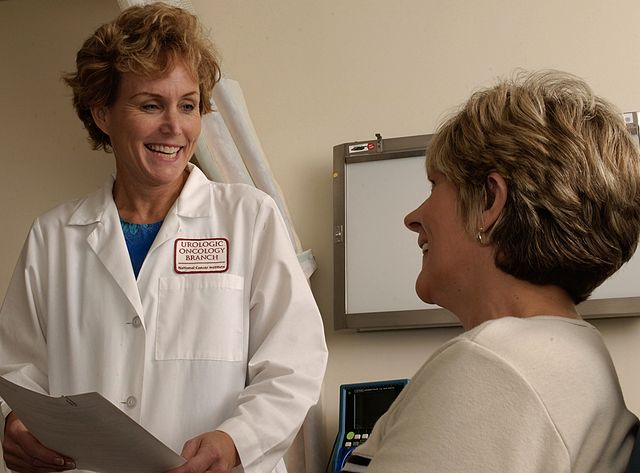Dysmenorrhea, or painful menstruation, is thought to affect nearly 20% of women. A recent study completed in Malaysia surveyed 1295 girls aged 13-19 from 16 different public schools. 76% of the participants reported having dysmenorrhea, and over half of these girls reported that concentration at school and participation in social events was most affected. 76% of them also stated they thought dysmenorrhea was a normal part of adolescence, and less than 15% sought help from the medical field.
One of the most simple and well-documented treatments for dysmenorrhea is a TENS unit, which has been recognized in the literature as decreasing need for pain medications and for decreasing absenteeism due to abdominal pain and cramping. In mmHG, uterine pressures due to menstrual cramping have been measured at numbers equal to uterine pressures measured in childbirth, a clear accounting of why these cramps can be so painfully debilitating.
We have little evidence to support physical therapy as a treatment recommendation for dysmenorrhea, as you can deduce from this summary article, however, it has been my professional experience that physical therapists and other pelvic rehab therapists can offer helpful stretches, self-care, and education to assist in diminishing symptoms. It has also been my experience that the mothers of the teenagers suffering from dysmenorrhea are the people who request care for such an issue. We can take the opportunity to inquire about our patient's daughters and discover if this is a concern of theirs. As the researchers in the above-mentioned Malaysian study state, there is a "...need for educating adolescent girls on effective management of dysmenorrhea.", and this education must be extended towards parents and school peer leaders.
In this brief and interesting Medscape video lecture, Dr. Gerald Chodak discusses the relevance of new research addressing men’s expectations following prostate surgery. 152 patients who had received extensive preoperative counseling regarding prostate surgery and expected outcomes completed a survey prior to and one year following their surgery. The surveys asked for responses about incontinence, bowel and sexual function, among other variables.
At one year following surgery, 47% and 44% of the men reported having lower than expected function for urinary incontinence and sexual function, respectively. The researchers report surprise that 12-17% of the men expected better than baseline urinary and sexual function following surgery. The study concludes that “Men have unrealistic expectations of…function after prostatectomy despite preoperative counseling.” The study also hypothesizes possible psychological causes for this reaction.
We have all met patients who are frustrated with post-surgical outcomes when their expectations are not achieved. These patients can sometimes be so frustrated that it may impair the ability to “move on” and focus on the level of function or healing that is available. It may be that we have opportunities to work with these men on a pre-operative basis, and it may be helpful for us to discuss the follow-up issues, if only for the patient to air any concerns and be directed towards the physician with any significant concerns.
Surgeons are often quick to remind patients that the goal of surgery is to “save lives, not preserve sexual function.” Some physicians focus on nerve-sparing techniques to minimize injury to the pelvic muscle function. Regardless of the surgeon’s approach, the patient may be interested in discussing the outcomes and the implications of the outcomes with his pelvic rehab professional. This research demonstrates that there is an important discrepancy between patient’s expectations and the outcomes.
I recently had the opportunity to sit down for a chat with Dawn Sandalcidi, PT, faculty member and national leading expert in pediatric continence. In truth, she was indulging me with her vast experience and giving me tips and encouragement towards treating children who have incontinence. I, perhaps like many of you reading this, have taken Dawn's pediatric incontinence course, yet I have not yet launched a pediatric incontinence program. Until now. After I took her course a few years ago, I vowed that I would begin treating children with bowel and bladder issues. After all, how many times have you heard the response "ever since I can remember?" when you ask your adult patients how long they have dealt with their current pelvic dysfunctions?
I (kindly and respectfully) challenge us as pelvic rehabilitation specialists to dive further into the realm of helping children who no doubt have no one else to turn to for meaningful advice. If you already treat children, good on you! It has been my experience that it is very difficult to find a provider who can treat children as well as adults. Often I believe that we get so busy with our clinic caseloads that it feels overwhelming to begin another program. Like many other challenges, if you take the first step, the rest you can figure out with some helpful resources.
If you have a biofeedback program, then you have all the special equipment you need. To begin a pediatric program, you might also like to acquire the Pediatric Pelvic Floor Manualas it has age-appropriate educational tools. Another great resource that Dawn recommends is the International Children's Continence Society website. It has an immense amount of evidenced-based work as well as patient-friendly literature. Click here to find out when the next pediatric course will be taught by Dawn Sandalcidi, or This email address is being protected from spambots. You need JavaScript enabled to view it. if you would like to host a course.
Perhaps if we all could treat the kids who need help with bowel and bladder function, we would hear fewer stories involving decades of struggle with pelvic floor issues. I have felt a little intimidated about beginning a pediatric program, yet I know that I have the tools, the education, and helpful experiences with adult populations. I hope this post will be encouragement for any of our readers who have thought about adding a pediatric program to your practice. As for me, I have some marketing to do.
In a study completed at the University of Sassari in Italy, physicians addressed post-menopausal pelvic floor changes such as stress urinary incontinence (UI), urogenital atrophy, and recurrent urinary tract infections. Half of the 206 post-menopausal women in this study were treated with intravaginal estriol (1 mg treatment daily for 2 weeks then 2 treatments/week for a total of 6 months). The other half was treated with estriol in addition to pelvic floor rehabilitation.
The outcomes measured at beginning and 6 months after start of treatment included urine cultures, urogenital symptomatology, and urethral pressure profiles, among other measures. At 6 months, urogenital atrophy was improved in both treatment groups. While in the control group (estriol only) patients reported a 9.71% improvement in urinary incontinence, 73.49% of the patients who were treated with estriol plus pelvic floor rehabilitation reported improvements in UI. Urethral closure pressures were also significantly improved in the estriol plus rehab group.
The authors conclude that pelvic floor rehabilitation in addition to estriol should be considered as first-line therapy for symptoms of urogenital aging in postmenopausal women.
Dr. G. Willy Davila of the Cleveland Clinic Florida has published an article in Advances in Urology that describes non-surgical management of female stress urinary incontinence. He reviewed the literature for prospective clinical trials and included only those studies that had a minimum 12 months of follow-up. Interestingly, most of the studies involving pelvic floor rehab only had follow-up for 6 months.
This article confirms prior research reviews in identifying pelvic floor rehabilitation as a low cost, low risk treatment that has well-proven short term benefits with 60-77% of patients benefiting from conservative treatment. Dr. Davila points out that level one evidence (randomized, controlled trials) are difficult to complete for this population as blinding is difficult when varied treatments are needed to compare conservative management techniques.
Also described and reviewed in this full-access article are the non-surgical techniques of urethral bulking and transurethral radiofrequency collagen denaturation used for urethral hypermobility. Urethral bulking involves an injection that is designed to augment the urethral sphincter. While many patients report benefit from this treatment, the collagen injections usually have to be repeated within a year. The radiofrequency treatment, as pointed out in the article, is not the same as transvaginal radiofrequency tissue ablation because the newer technique requires no incision and uses a much lower temperature that avoids tissue necrosis and shrinking. The radiofrequency collagen denaturation instead creates tissue remodeling. In a 3 year follow up study using this technique, Appell et al reported a 50% or more reduction in stress incontinence for 56% of women in the study.
While patient adherence has been found to be understandably necessary for pelvic floor therapy to assist in patient recovery from stress incontinence, it is recommended as the first line of treatment. This review of available research is helpful towards understanding what literature is available to support pelvic rehab, and it is also useful in pointing out what needs remain: namely, more long-term follow-up (at least 12 months), and more standardized terminology and methodology.
Chronic pain following hernia repair has been estimated in the literature to be as high as 54% for inguinal hernia repair. Pain is often categorized as neuropathic or non-neuropathic. Recent research appearing in the Annals of Surgery and reported on in Medscape Today discusses nerve management in relation to post herniorrhaphy pain. (You can register with the Medscape site to receive weekly updates.)
The authors designed a prospective cohort study and they report on 781 elective hernia operations that were performed on 736 patients in a hernia center. The preoperative pain rate was 41%. At 6 months assessment, chronic pain was reported by 16.5%, sensory disorders (such as numbness or dysesthesia) were reported in almost 16% of patients. At 5 years following surgery, 571 men and 74 women were re-evaluated (follow-up rate of 82.6%) with chronic pain rate of 16.1% , sensory disorder of 20.3%. Independent predictors of post-surgical pain included pre-operative pain and a groin sensory disorder.
The authors make recommendations for surgical approaches, and they discuss the likelihood that nerve contact with surgical mesh or nerve tissue that is surrounded by fibrosis can create significant pain. While there is very little in the literature to support physical therapy and post-herniorrhaphy pain, this pain pattern may be very well treated post-surgically. The nerves that are most involved with a hernia repair (ilioinguinal, iliohypogastric, and the genital branch of the genitofemoral) can be assessed and may be treated with neurodynamics techniques, well described by David Butler and colleagues of the Neuro Orthopedic Institute. Patients with pain or dysesthesia stemming from these nerves may arrive in the clinic of the pelvic rehab practitioner as these nerves travel distally to the groin area.
For more information about current management of post-herniorraphy groin pain, click here for a recent update.
A pilot study addressing urinary incontinence (UI) in patients who have Parkinson Disease (PD) appeared in the journal Neurology. The studyutilized biofeedback training of pelvic floor muscles and urge suppression techniques along with use of a bladder diary in a series of 5 visits over an 8 week period.
17 of 20 patients (90% male) who were recruited from movement disorders clinics completed the study. Mean age of the patients was 66 years and the mean length of time diagnosed with PD was nearly 7 years. At the time of entry to the study the participants had a median of 9 episodes of urinary leakage per week.
Following the intervention, weekly episodes of UI recorded by bladder diary was reduced to 1 time per week. Quality of life scores on the ICIQ-OAB were also significantly reduced. The authors note that following this pilot study, randomized controlled trials are needed to further validate the benefits of exercise-based behavioral intervention for urinary incontinence reduction in patients who have Parkinson Disease.
It has been recognized in the literature that additional burden is placed on patients and on caregivers when those who have PD. Reducing such comorbidities can thereby hope to reduce such burden.
Today the US Food and Drug Administration (FDA) issued an alert about mesh used in transvaginal placement for pelvic organ prolapse (POP). This mesh which can be made from synthetic or biologic material is placed permanently to repair weakened tissues.
Serious complications have been reported due to surgical mesh, the most common one is that of mesh erosion through the vaginal tissue. The mesh can also shrink and create vaginal tightening and pain, thereby limiting sexual function. This is not only known to be problematic for women, but men can experience pain during intercourse with a female partner due to mesh. This was identified in the literature as "hispareunia."
So, what does this mean for the pelvic rehab professional? Inquiring about surgical histories including the placement of mesh is very important. If a patient has mesh erosion, there may be no amount of relief to be gained until the mesh issue is resolved. You may feel the mesh yourself as a sharp or non-tissue like structure along the vagina. If you have any doubt that mesh erosion has occurred, or if your patient is dealing with significant stenosis or canal narrowing after their procedure, request that the patient return to the provider.
The alert contains recommendations for surgeons as well as for patients so that patients can make informed decisions with respect to the risk mesh placement can pose. A prior warning was issued by the FDA in 2008 stating that severe mesh complications were rare; the update on their website today indicates that the issue remains one of serious concern that is no longer considered to be rare. Watch for further updates from the FDA as they continue to meet and evaluate the research related to this topic.
I used to think that supercalifragilisticexpialidocious was a very cool word to know. (Ok, when I was 12 it seemed cool.) I found a new word that will perhaps light a fire for you, too, especially if your inner anatomy nerd is needing some attention during the heat of summer. While reading an original article by Yabuki et al in Female Pelvic Medicine & Reconstructive Surgery (2011;17: 60-66) I came across this word: sacrorectogenitovesicopubic. It was followed by the phrase lamina of Farabeuf.
The authors of this article lament the fact that anatomy terms are challenging to work with because the surgical anatomy is described differently from clinical anatomy. They set out to redefine pelvic connective tissue through cadaver dissection as well as through histology studies. A figure in the article divides the pelvic connective tissues into a "supporting system" and a "suspensory system" with various ligaments and named fascia.
This article highlights a few things in my opinion. One, anatomy is a living science, and it continues to be researched and redefined as surgeons and other disciplines find needs for sharing information and for shaping best practices. It is also important to remember that surgeons are amazing resources, and one can really "get" anatomy while observing a surgery and listening to a surgeon describe layers of fascia or muscles as they pertain to the procedure. Lastly, we can continue to be engaged in learning and re-learning anatomy, as it sets the foundation for the stories that bodies tell.
If you are inspired to study a bit of cadaver anatomy, here is an interesting link that will take you to an on-line education program's anatomy. Scroll down once you open the link to get to pelvis and perineum.
An intervention study involving physical therapy was included as an abstract and poster presentation at the American Society of Clinical Oncology (ASCO). Female breast cancer survivors have significant complaints of sexual dysfunction including vaginal dryness and dyspareunia. 37 women were enrolled in this study and were instructed to apply Replens( a vaginal moisturizer) 3 times per week, perform pelvic floor muscle exercises 2 times per day, and to utilize olive oil during intercourse.
A pelvic physiotherapist instructed the patient in the pelvic muscle intervention at 0, 4, 12 and 26 weeks, measuring pelvic muscle function with manometry and with surface EMG.
The women who participated in this study reported significant improvement in overall sexual function and in dyspareunia. Maximal benefits were reported at 12 weeks, with additional follow-up occurring at 26 weeks. Quality of life measures improved as well.
Because sexual dysfunction is reported in such high numbers in the literature (up to 50% as referenced in this study), there are clearly more women in our communities who need our assistance. Whether a patient needs more muscle activity or less is best determined by the physical therapist who can be a part of a cancer care multidisciplinary team. Are there oncologists in your area who would love to meet you and find out more about what you have to share?
By accepting you will be accessing a service provided by a third-party external to https://www.hermanwallace.com/










































